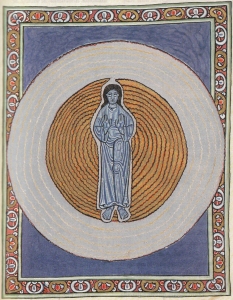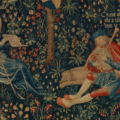Hildegard of Bingen was a flame burning in the shadows of the 12th century. A Benedictine nun, prophetess, healer, composer, and visionary, her life unfolded between the stone walls of the monastery and the vastness of the inner sky. From childhood, she claimed to hear a luminous voice revealing to her the mysteries of the cosmos and the soul.
Against all odds in a world ruled by men, Hildegard raised her voice with serene strength—writing to popes and emperors, composing celestial hymns, and putting into words the ineffable. Her legacy belongs not only to her time but to all those who seek the sacred in the everyday.

Among her works, Scivias—short for Scito vias Domini, “Know the ways of the Lord”—shines as a map of visions and symbols that are not walked with the feet but with the soul. Written after years of inner struggle and obedience to a divine voice urging her to write, this work unfolds twenty-six visions structured in three thematic parts: a theological, cosmological, and allegorical account of the world as she perceived it through a phenomenon she called the Reflection of the Living Light. It is not a treatise, but a journey; not a lesson, but a revelation. Each image, each word, pulses like an open door to mystery, inviting the reader to embark on their own path toward the light.
While not a pilgrimage in the literal sense, Scivias offers a model of interior progression—an itinerary of the soul shaped by medieval understandings of moral, cosmic, and ecclesiastical order.
Mapping the Soul’s Terrain
The title itself echoes the structure of a route. The Latin word vias (“ways”) evokes movement, transit, and navigation. Hildegard’s visions unfold in stages that describe a metaphysical journey—beginning with the origins of creation, traversing salvation history, and culminating in an apocalyptic future. This arc suggests progression, guidance, and transformation, much like the purpose of physical pilgrimage in her time: penitence, spiritual realignment, and discovery.
Unlike pilgrims traveling toward Jerusalem or Compostela, Hildegard’s route is not marked by shrines or relics, but by symbols, voices, and archetypes. Yet her experience remained deeply grounded in the physical. She fell ill, weakened by her initial refusal to “cry out and write,” and only began recording after intense inner struggle and the encouragement of those around her. In this way, her work mirrors the pilgrim’s challenge: a call to transformation that resists ease, demands endurance, and ultimately reshapes the self.

From Vision to Shared Map
Her visions received public validation at the Synod of Trier in 1147–1148, when excerpts of Scivias were read aloud before Pope Eugenius III. This moment granted her both ecclesiastical approval and wider circulation. In this context, Scivias became a form of “popular theology”—not in the sense of simplification, but in its power to reach the hearts of many. It became a shared map—not for navigating physical territories, but for orienting oneself within the complexities of salvation, virtue, and divine order.
The themes of Scivias—cosmic design, ecclesiastical hierarchy, and apocalyptic closure—parallel the spiritual arc envisioned by medieval pilgrims. It did not replace the act of physical journeying, but offered a meditative route aligned with its values—a faithful companion for seekers, whether on the road or in the cloister of the soul.
Today, the monastery sites associated with Hildegard—Disibodenberg, Rupertsberg, and Eibingen—can be visited by modern pilgrims, walking (for real) the Hildegardweg. But the true path she traced lies within Scivias: an interior cartography, drawn in light, through which the soul may still travel toward the divine.





